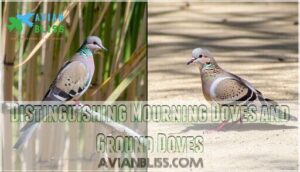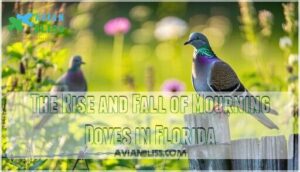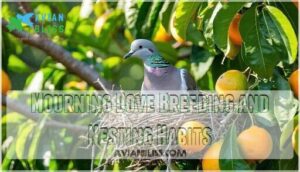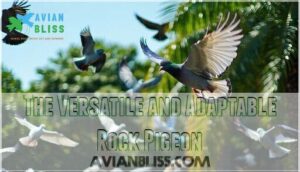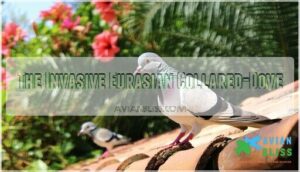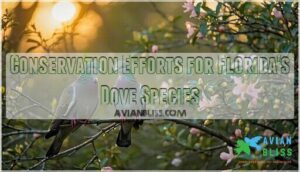This site is supported by our readers. We may earn a commission, at no cost to you, if you purchase through links.
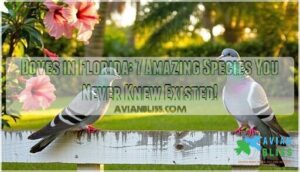
The Sunshine State hosts eight unique dove species, from the familiar mourning dove to the invasive Eurasian collared-dove.
You’ll spot these feathered friends in urban parks, backyard gardens, and rural landscapes.
Each species has its own quirks – some blend into cityscapes, while others prefer quieter woodland edges.
Mourning doves, with their soft gray plumage and gentle cooing, are the most common, but don’t be surprised by white-winged or ground doves darting around.
Their adaptability makes them fascinating wildlife neighbors that’ll keep your local ecosystem buzzing with life.
Table Of Contents
- Key Takeaways
- Doves and Pigeons Found in Florida
- Distinguishing Mourning Doves and Ground Doves
- The Advantages of Having Doves in Your Yard
- The Rise and Fall of Mourning Doves in Florida
- Mourning Dove Breeding and Nesting Habits
- The Versatile and Adaptable Rock Pigeon
- The Invasive Eurasian Collared-Dove
- Conservation Efforts for Florida’s Dove Species
- Frequently Asked Questions (FAQs)
- What is the best time to see common birds in Florida?
- What are some of the most common birds found in Florida?
- Where can I go to see common birds in Florida?
- Are there any special precautions I should take when observing birds in Florida?
- What equipment do I need to observe birds in Florida?
- What kind of doves do we have in Florida?
- What does it mean when a dove stays in your yard?
- Is it good to have doves in your yard?
- What are the common types of doves found in Florida?
- What distinguishes the White-winged Dove from other doves?
- Conclusion
Key Takeaways
- You’ll find eight unique dove species in Florida, ranging from the common Mourning Dove to the invasive Eurasian Collared-Dove, each with distinctive characteristics that adapt to urban and rural landscapes.
- If you’re interested in attracting doves to your yard, you’ll want to create a wildlife-friendly environment with low-profile feeders, native plants, and ground-level seed sources that support their feeding and nesting habits.
- You should be aware that dove populations face significant challenges, including habitat loss, climate shifts, and urban development, making conservation efforts critical for preserving these resilient bird species.
- By understanding dove behaviors, feeding patterns, and breeding cycles, you’ll gain insights into their remarkable ability to thrive in diverse Florida ecosystems, from city parks to quiet suburban gardens.
Doves and Pigeons Found in Florida
You’ll be amazed by the diverse array of doves and pigeons that call Florida home, from the ubiquitous Mourning Dove to the invasive Eurasian Collared-Dove.
Take a journey through the Sunshine State’s feathered landscape and discover the unique characteristics, behaviors, and habitats of these fascinating birds that might be right in your backyard, showcasing the diverse array of species.
Mourning Dove
Throughout Florida’s diverse landscapes, Mourning Doves dance through the air with graceful wings and soft, melancholic calls.
Graceful wings paint melancholic melodies across Florida’s skies, where Mourning Doves whisper their gentle song.
These resilient birds have mastered urban survival, adapting to various environments with remarkable ease.
Here’s what makes them extraordinary:
- They breed up to six times annually
- Their grayish-brown feathers blend perfectly with urban backdrops
- Prefer ground feeding near shrubs and trees
- Produce distinctive cooing sounds that signal their presence
- Can be found perched on telephone wires or scattered across open fields
Their subtle elegance tells a story of survival and showcases their ability to thrive in different environments with remarkable ease.
Rock Pigeon
After the Mourning Dove’s flight patterns, meet its urban cousin: the Rock Pigeon.
These adaptable urban birds have mastered city living across Florida’s landscapes.
With shimmering feathers and compact bodies, they’re nature’s ultimate street survivors.
Rock Pigeons feast on seeds, crumbs, and urban scraps, thriving where other bird species struggle.
Their bustling flocks bring life to parks and sidewalks, turning concrete jungles into vibrant ecosystems.
Short-lived but incredibly resilient, these feral pigeons represent the true spirit of urban wildlife adaptation.
Eurasian Collared-Dove
If rock pigeons are the street performers of Florida’s bird world, the Eurasian Collared-Dove is its ambitious newcomer.
These sandy-brown invaders have mastered urban adaptation with their distinctive black neck ring and clever survival skills.
- Rapidly colonizing Florida’s landscape
- Masters of seed-based cuisine
- Urban dwelling experts
- Distinctive "koo-KOO-kook" trademark call
Their bird dispersal strategy has transformed local ecosystems, making them a fascinating example of wildlife resilience in the Sunshine State.
Common Ground Dove
Meet the tiny powerhouse of Florida’s dove world: the Common Ground Dove—a sparrow-sized marvel that’s easy to overlook but impossible to ignore once spotted.
These masters of camouflage roam urban gardens and open spaces, blending seamlessly with their muted brownish-gray plumage and chestnut-toned wings.
| Characteristic | Details | Significance |
|---|---|---|
| Size | Sparrow-sized | Perfect ground forager |
| Habitat | Urban gardens, open spaces | Adaptable ecosystem |
| Diet | Seeds, grains | Ground-level feeding |
| Nesting | Monogamous | Tight-knit pairs |
| Vocalization | High-pitched coos | Surprising volume |
Their soft, repetitive calls carry surprising volume, announcing their presence in Florida’s diverse dove landscape.
These ground-dwelling birds navigate life’s challenges with remarkable resilience, dodging predators and surviving in urban environments.
White-winged Dove
How might a white-winged splash of feathered elegance grace your Florida landscape? These distinctive doves, sporting bold white wing stripes and dramatic black cheek markings, transform ordinary backyards into avian havens.
Understanding their white winged dove habits can help attract them to your yard.
- Scatter sunflower seeds strategically
- Create native plant sanctuaries
- Maintain fresh water sources
- Eliminate harmful pesticides
Their melodic "who cooks for you" calls invite wild wonder into your outdoor space.
Distinguishing Mourning Doves and Ground Doves
If you’ve ever squinted at a small bird hopping on the ground and wondered, "Is that a Mourning Dove or a Ground Dove?" you’re not alone.
By understanding key differences in size, coloration, and behavior, you’ll quickly become an expert at distinguishing these two fascinating Florida dove species, specifically the Ground Dove.
Size and Appearance
The diversity of Florida’s dove species springs to life through their distinctive physical attributes.
Each bird tells a unique story through its silhouette and proportions.
Check out how these feathered friends compare in size and shape:
| Species | Body Size | Bill Shape | Wing Markings | Tail Length |
|---|---|---|---|---|
| Mourning Dove | Medium | Slender | Black spots | Long, pointed |
| Common Ground Dove | Small | Short | Chestnut tones | Short, compact |
| White-winged Dove | Medium | Slender | White edges | Medium |
| Rock Pigeon | Large | Thick | Two black bars | Medium |
| Eurasian Collared-Dove | Medium-large | Slender | Plain gray | Long, rounded |
Their unique plumage types and beak shapes make Florida dove species a fascinating study for backyard birdwatchers and nature enthusiasts alike.
Coloration
Florida’s dove palette paints a subtle canvas of feather patterns that’ll make you a backyard birding pro.
Observe how Mourning Doves rock soft gray plumage with dramatic black wing markings, while Common Ground Doves sport understated brown and pinkish hues.
5 Coloration Insights:
- Gray meets black in Mourning Dove elegance
- Pinkish blush highlights ground dove subtlety
- Wing markings reveal species identity
- Camouflage colors blend with landscape
- Tail colors distinguish dove varieties
The key to identifying these doves lies in their distinctive wing markings and coloration patterns, which set them apart from other bird species.
Behavior and Habitat
When you compare mourning doves and ground doves, their behaviors reveal nature’s intricate design. Their habitat preferences paint a vivid picture of survival strategies in Florida’s diverse landscapes.
- Mourning doves soar and glide across open fields
- Ground doves dart low, hugging protective shrub cover
- Nesting heights differ dramatically between species
- Feeding patterns reflect unique ecological niches
- Social structures showcase distinct survival adaptations
While mourning doves confidently occupy tree branches and wide-open spaces, ground doves masterfully blend into low-lying vegetation. Their foraging habits tell a story of specialized urban and rural adaptation.
Migration patterns demonstrate remarkable resilience, with each species carving out its own territory in Florida’s rich bird habitats. These winged survivors dance to different rhythms, proving that diversity isn’t just about appearance—it’s about how creatures navigate their world, showcasing remarkable resilience and unique ecological niches, with a clear display of distinct survival adaptations.
The Advantages of Having Doves in Your Yard
If you’re looking to transform your yard into a vibrant wildlife sanctuary, attracting doves can be an exciting and rewarding experience.
By creating a dove-friendly environment with strategic food sources and suitable habitats, you’ll also support local bird populations and enjoy the gentle beauty and melodic cooing of these remarkable feathered friends.
Attracting Doves to Bird Feeders
Because doves love an easy meal, set up low-profile feeders near water sources in your yard.
Sprinkle millet and safflower seeds directly on the ground or in sturdy platform feeders to attract doves in Florida.
Choose locations with clear visibility, allowing these charming bird species to feel safe while feeding comfortably.
Using the right bird feeder types can substantially enhance the attractiveness of your yard to doves.
Benefits of Dove Presence
Nature’s winged whispers, doves are more than just pretty feathered friends—they’re ecological powerhouses transforming your backyard into a vibrant wildlife sanctuary.
When you welcome these gentle birds, you’re supporting complex urban ecosystems and contributing to broader wildlife conservation efforts.
- Seed dispersal dynamos: Spreading plant life across landscapes
- Natural pest control agents
- Biodiversity boosters
- Ecosystem balance architects
- Living indicators of environmental health
Their quiet presence tells a story of resilience and interconnectedness.
By understanding dove ecology, you’re not just observing birds—you’re participating in a delicate dance of urban wildlife conservation.
Each dove represents a tiny but mighty guardian of Florida’s intricate natural tapestry, silently working to maintain the delicate balance of our shared environment.
Considerations for Dove-Friendly Yards
Your backyard’s dove sanctuary starts with strategic planning. Create ground-level feeders stocked with millet, sunflower seeds, and native berries to attract Florida’s dove species.
Plant evergreen shrubs for sheltered nesting sites and install a shallow birdbath for hydration. By designing a wildlife-friendly landscape, you’ll transform your yard into an inviting haven that supports dove habitats and local bird conservation efforts.
Effective bird feeder systems, such as those using bird feeding options, can enhance the overall dove-friendly environment, creating a haven that is truly dove-friendly.
The Rise and Fall of Mourning Doves in Florida
You’ve probably spotted mourning doves perched on power lines or pecking at seeds in your backyard, but you mightn’t know they’re quietly facing significant population challenges in Florida.
Their story reveals a complex tale of environmental shifts, habitat changes, and the delicate balance of urban wildlife survival.
Mourning Dove Population Decline
The whispers of Mourning Doves might soon fade from Florida’s skies. After your peaceful backyard moments with these gentle birds, you’ll want to understand their shrinking world.
Their population is quietly sliding, with a 20% decline since 1966. Imagine these challenges:
- Concrete replacing green spaces
- Silent battles against habitat destruction
- Breeding rhythms disrupted by changing landscapes
While nationwide numbers hover around 346 million, Florida’s local populations tell a different story. Scientific tracking reveals a 2% population decrease in the last decade, signaling potential long-term risks.
Conservation isn’t just about numbers—it’s about preserving the delicate soundtrack of our natural world. By understanding Mourning Dove challenges, we can help these resilient birds continue their song.
Factors Contributing to Population Changes
Just 5 key factors threaten dove populations in Florida: habitat loss slashes nesting spaces, climate shifts disrupt migration patterns, limited food availability weakens survival rates, increased predation pressures young birds, and disease outbreaks risk entire populations.
Human activities inadvertently accelerate these challenges, transforming landscapes and compromising dove species’ delicate ecological balance.
Understanding the role of raptors and prey is essential to addressing these challenges and preserving the balance of Florida’s ecosystems.
Conservation Efforts
Florida’s dove conservation efforts are a tribute to collaborative wildlife protection.
Organizations like Conservation Florida and Audubon Florida lead the charge in protecting these delicate species through strategic initiatives:
- Preserve critical habitats across 100,000+ acres
- Support scientific research and population monitoring
- Engage community members in citizen science projects
- Develop education programs about native dove species
By joining local wildlife conservation groups, you’ll directly impact dove preservation.
Planting native vegetation, participating in banding programs, and supporting responsible ownership can transform your backyard into a sanctuary.
Your involvement guarantees these remarkable Florida dove species continue to thrive, bridging the gap between human activity and wildlife sustainability.
Mourning Dove Breeding and Nesting Habits
You’ll be amazed by the incredible breeding and nesting habits of mourning doves, a common yet fascinating species in Florida.
These resilient birds can lay up to six clutches of eggs per year, creating intricate nests in trees, shrubs, and even urban structures with remarkable precision and care, showcasing their ability to thrive in various environments, which is a key aspect of their resilient nature.
Prolific Breeding Cycles
One might marvel at the extraordinary breeding prowess of mourning doves in Florida’s diverse ecosystems.
These resilient birds defy typical seasonal constraints, producing an impressive 3-6 broods annually with remarkable consistency.
Their reproductive strategy includes:
- Early sexual maturity, breeding as young as three months old
- Year-round reproductive cycles adapted to warm climates
- High survival rates supported by dedicated parental care
Each dove pair potentially raises up to 12 chicks per year, transforming their reproductive approach into a biological masterpiece.
Abundant food sources and ideal nesting environments in Florida provide the perfect backdrop for these prolific breeders.
Their ability to sustain multiple breeding cycles demonstrates an unparalleled evolutionary advantage in avian reproductive strategies, showcasing their remarkable reproductive approach and dedicated parental care.
Nesting Behavior
After your doves finish their breeding cycle, watch their nesting magic unfold.
Their twig platforms emerge like miniature architectural wonders, strategically placed 5-25 feet high in tree crotches.
Nature’s efficiency shines as pairs construct homes in mere hours, with both parents sharing incubation duties.
These modest platforms become bustling nurseries, ready for Florida’s avian families.
| Nesting Aspect | Dove Details |
|---|---|
| Height Range | 5-25 feet |
| Construction Time | Hours |
| Incubation Period | 14 days |
| Nest Reuse | Common |
Parental Care and Feeding of Young
After carefully constructing their nest, mourning dove parents undertake an extraordinary journey of brood rearing that’ll amaze bird enthusiasts.
These devoted caregivers produce a remarkable substance called crop milk, a nutritious secretion that sustains their young during the critical first week of life. Both male and female doves share parental responsibilities with impressive synchronization, taking turns feeding their squabs by allowing them to push their heads into specialized crop pouches.
The feeding process transforms dramatically over just ten days:
- Nature’s most heartwarming display of unconditional love
- A demonstration to survival’s delicate dance
- Breathtaking choreography of parental instinct
- Silent symphony of avian care
From the unique crop milk diet to gradual seed introduction, these parents demonstrate an incredible commitment to their offspring’s survival. By day ten, fledglings shift to a complete adult diet, showcasing the remarkable adaptability of dove species in their intricate bird breeding cycles.
The Versatile and Adaptable Rock Pigeon
You’ve probably seen rock pigeons everywhere, from busy city streets to quiet suburban neighborhoods, without realizing their incredible adaptability.
These urban survivors have mastered the art of thriving alongside humans, transforming from wild rock doves to the familiar city pigeons you encounter daily, showcasing their ability to be urban survivors.
History of Rock Pigeons and Humans
Rock pigeons carry an extraordinary legacy that stretches back millennia, connecting human civilization with remarkable avian companions.
Rock pigeons: ancient messengers bridging humanity’s story, from wartime communication to urban survival.
Domesticated around 2500 B.C., these birds were originally prized as message carriers, transforming from wild rock doves into invaluable partners across cultures.
Their journey tells a story of human migration and adaptability, serving critical roles from wartime communication to religious symbolism.
English colonists brought these versatile birds to North America, establishing the feral populations you now see throughout Florida’s urban landscapes.
Imagine pigeons that once carried critical messages across battlefields now perched on city buildings – survivors of an ancient partnership that continues to thrive.
Their resilience mirrors our own capacity for connection and survival.
Thriving in Urban Environments
Ever watched rock pigeons conquering Florida’s urban jungle? These feathered survivors transform concrete landscapes into thriving kingdoms, mastering city living with remarkable skill.
Their ancient cliff-dwelling instincts perfectly translate to metropolitan environments, allowing them to thrive in a new setting.
Urban survival strategies include:
- Nesting on architectural ledges like tiny skyline architects
- Scavenging food from bustling street corners
- Traversing complex human territories with stealth
- Blending seamlessly into architectural backgrounds
- Outsmarting potential predators through strategic positioning
By leveraging human infrastructure, these adaptable birds redefine urban wildlife survival, turning cityscapes into their personal playground. They exhibit remarkable rock pigeon behavior that enables them to thrive in various environments, showcasing their ability to adapt to metropolitan environments and master the art of urban survival with remarkable skill.
Interactions With Bird Feeders
At sunrise, these urban feathered foragers swoop onto backyard platform feeders, transforming your yard into a bustling avian dining hall.
Their adaptable feeding habits make them welcome guests, quietly consuming seeds while maintaining a delicate urban ecosystem balance.
| Feeder Type | Seed Preference |
|---|---|
| Platform | Cracked Corn |
| Hanging | Milo Seeds |
| Ground | Mixed Grains |
| Elevated | Sunflower Mix |
These birds are a great addition to any yard, and their love for seeds makes them easy to attract with the right feeder.
The Invasive Eurasian Collared-Dove
When you spot a Eurasian Collared-Dove in Florida, you’re witnessing an invasive species with a remarkable story of adaptation and spread.
These distinctive birds, marked by their black half-collar and white tail patches, have rapidly colonized urban and suburban landscapes since their introduction in the 1970s, transforming the local dove ecosystem into a new environment with the Eurasian Collared-Dove.
Adaptability and Population Growth
You might be surprised to learn how the Eurasian Collared-Dove conquered Florida’s landscape. These remarkable birds transformed from occasional Bahamas visitors to dominant residents through extraordinary urban adaptation strategies.
Their population exploded from mere dozens to over 100,000 in Miami-Dade and Monroe counties by the early 1990s, highlighting their incredible habitat expansion capabilities. With distinctive sandy-brown plumage and a bold black collar, these doves showcase remarkable migration patterns and species interactions.
Their success stems from incredible diet flexibility and impressive predator avoidance skills. They’ve seamlessly integrated into diverse environments, from bustling city streets to tranquil suburban gardens.
The Eurasian Collared-Dove’s population growth of 13% annually demonstrates their unparalleled ability to thrive in human-altered landscapes. Their story represents a masterclass in wildlife adaptation, turning Florida into an unexpected sanctuary for these resilient birds. The species’ invasive status is characterized by its rapid expansion trends, making it a notable example of adaptability in avian ecology.
Impact on Native Dove Species
The ecological disruption of Florida’s dove populations reveals a complex narrative of invasive species adaptation.
Eurasian Collared-Doves have transformed local wildlife dynamics, strategically positioning themselves in suburban landscapes where native dove species struggle.
These pale gray interlopers, distinguished by their distinctive black neck rings, effectively compete for limited resources in urban and agricultural environments.
Research suggests minimal direct hybridization, but their expanding presence signals significant challenges for native dove migration patterns and ecological balance.
Wildlife conservation experts closely monitor these population shifts, recognizing the potential for habitat fragmentation and native species decline.
Your backyard bird feeder might now showcase more of these adaptable newcomers, highlighting the ongoing tension between invasive and indigenous dove species in Florida.
Their strategic colonization demonstrates nature’s remarkable capacity for unexpected transformations.
This phenomenon underscores the need for continued observation and study of the dynamics between native and invasive species, particularly in sensitive ecosystems like those found in Florida, where native dove species are affected.
Conservation Efforts for Florida’s Dove Species
You can make a real difference in protecting Florida’s diverse dove populations by understanding their unique conservation needs and supporting local wildlife initiatives.
By learning about habitat preservation, responsible pet ownership, and the critical role of native plants, you’ll become a vital ally in safeguarding these remarkable birds for future generations, which involves native plants.
Supporting Wildlife Organizations
Local wildlife guardians are champions of Florida’s dove protection, transforming small actions into powerful conservation movements.
Your involvement can create meaningful change through strategic engagement with dedicated organizations.
- Release your passion by joining bird watching communities and connecting with fellow wildlife enthusiasts
- Transform your curiosity into action by supporting targeted donation strategies
- Amplify conservation voices through hands-on volunteer work at nature centers
Organizations like Audubon Florida and the Florida Bird Conservation Initiative offer multiple pathways for community outreach.
Whether you’re contributing funds, sharing knowledge, or participating directly, your efforts help preserve Florida’s delicate bird ecosystems.
Every contribution matters in protecting our winged neighbors and their habitats, which is why strategic engagement and meaningful change are crucial for the conservation of these species.
Habitat Preservation and Native Plants
Nature’s blueprint for dove sanctuaries starts with strategic native plantings.
Transform your backyard into a vibrant wildlife corridor that supports Florida’s diverse dove populations. By carefully selecting native species like beautyberry, wild coffee, and muhly grass, you’ll create essential habitat restoration zones.
These plants offer critical food sources, protective cover, and nesting materials that maintain ecosystem balance. Your garden becomes a lifeline for doves, bridging fragmented landscapes and preserving the delicate interconnectedness of Florida’s rich wildlife ecosystems.
Effective native plant choices rely on understanding local native plant species, which is crucial for creating a thriving wildlife corridor that supports the local dove population and contributes to the overall ecosystem balance.
Responsible Pet Ownership and Education
Often, your role as a pet owner directly impacts the survival of Florida’s delicate dove populations. Cats pose a significant threat, causing millions of bird deaths annually.
Here’s how you can protect these feathered residents:
- Keep cats indoors or use supervised outdoor enclosures
- Install bird-safe window decals to prevent fatal collisions
- Support local wildlife rehabilitation centers
- Educate neighbors about responsible dove care
Understanding dove behavior and nutrition is essential for wildlife conservation. Contrary to popular belief, doves can’t digest pasta, so avoid inappropriate feeding.
By implementing these Pet Care Tips, you’ll create a safer environment for Florida’s dove species.
Your small actions can make a tremendous difference in Animal Welfare. Each responsible choice helps protect these vulnerable birds, ensuring they continue to thrive in their natural habitat. Remember, wildlife conservation starts right in your own backyard – one dove at a time.
Frequently Asked Questions (FAQs)
What is the best time to see common birds in Florida?
You’ll spot Florida’s common birds best during spring and fall migrations.
Dawn offers prime birdwatching hours, especially in coastal areas and wildlife refuges.
Bring binoculars and check local birding guides for peak viewing times.
What are some of the most common birds found in Florida?
You’ll discover Florida’s skies buzzing with mockingbirds, cardinals, herons, and pelicans.
If you’re lucky, you’ll catch glimpses of colorful woodpeckers, blue jays, and sandhill cranes dancing through diverse landscapes from coastal regions to inland habitats.
Where can I go to see common birds in Florida?
You’ll find Florida’s common birds at Everglades National Park, local wildlife refuges, state parks like Myakka River, botanical gardens, and wetland preserves.
Check local birding groups for specific viewing locations and seasonal migration patterns.
Are there any special precautions I should take when observing birds in Florida?
Wear light, long-sleeved clothing to protect from sun and insects.
Bring binoculars, water, and sunscreen. Stay hydrated, respect wildlife boundaries, and move quietly.
Watch for ticks and be aware of local wildlife regulations, and remember to stay hydrated.
What equipment do I need to observe birds in Florida?
Grab binoculars, a field guide, comfortable hiking shoes, and a lightweight backpack.
Pack water, sunscreen, and a hat. Bring a notebook for tracking sightings.
Don’t forget your camera to capture Florida’s vibrant bird diversity.
What kind of doves do we have in Florida?
In Florida, you’ll spot six dove species: Mourning, Common Ground, Eurasian Collared, White-winged, African Collared, and Zenaida.
Native and non-native varieties add color to your birdwatching adventures across diverse Florida landscapes, making it a unique experience with diverse landscapes.
What does it mean when a dove stays in your yard?
A dove in your yard signals potential nesting nearby.
It’s likely attracted to your landscape’s food sources, safety, and shelter.
You might be witnessing a bird establishing its territory or seeking a peaceful sanctuary.
Is it good to have doves in your yard?
Having doves in your yard can be a blessing.
They help control insect populations, add peaceful chirps, and create a harmonious ecosystem.
Their gentle presence can reduce stress and bring a sense of tranquility to your outdoor space.
What are the common types of doves found in Florida?
Hold onto your bird-watching binoculars, because Florida’s dove scene is a wing-tastic wonderland.
You’ll encounter Mourning Doves, Eurasian Collared-Doves, White-winged Doves, and adorable Common Ground Doves fluttering across urban and rural landscapes.
What distinguishes the White-winged Dove from other doves?
You’ll quickly spot a White-winged Dove by its distinctive white wing stripe, pale grayish-brown plumage, black cheek mark, and bright orange eye with a light blue ring.
It thrives in urban and coastal environments.
Conclusion
As if time-traveling from a bygone era, you’ve discovered Florida’s dove diversity! Exploring doves in Florida reveals a vibrant ecosystem where these feathered friends thrive.
From urban parks to quiet woodlands, each species tells a unique story of adaptation and resilience. Whether you’re a birdwatcher or nature enthusiast, understanding these winged neighbors enriches your appreciation of local wildlife.
Embrace their presence, protect their habitats, and let the gentle cooing of doves inspire your connection with nature.
- https://journals.flvc.org/edis/article/download/116853/115019
- http://www.wildsouthflorida.com/eurasian.collared.dove.html
- https://journals.plos.org/plosone/article?id=10.1371/journal.pone.0111510
- https://www.allaboutbirds.org/guide/Eurasian_Collared-Dove/species-compare/
- https://www.fosbirds.org/florida-bird-list.html

